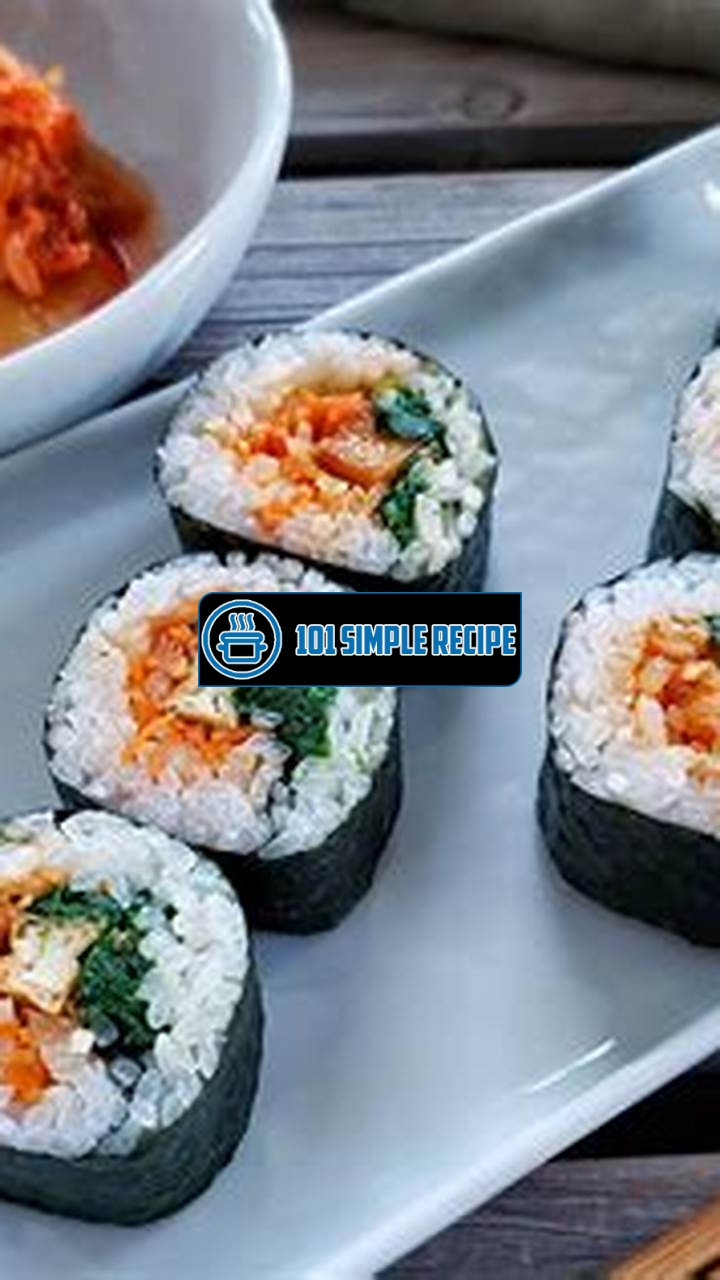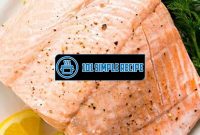Are you craving a delicious and healthy snack? Look no further than Korean Seaweed Rice Rolls! These tasty treats are packed with flavor and nutrients, making them the perfect option for a quick and easy meal. In this article, we will guide you through the process of making these mouthwatering rolls step by step, ensuring that you can recreate the authentic Korean taste in your own home. So, put on your apron and get ready to embark on a culinary adventure!

What are Korean Seaweed Rice Rolls?
Discover the traditional Korean dish known as seaweed rice rolls and why they have become popular worldwide.
A Brief History of Korean Seaweed Rice Rolls
Seaweed rice rolls, also known as kimbap or gimbap, are a popular staple in Korean cuisine. This dish originated in Korea during the Goryeo Dynasty, which lasted from 918 to 1392. It was primarily consumed by the ruling class and wealthy individuals due to its expensive ingredients.
Over time, seaweed rice rolls gained popularity among the common people as well. The dish became an essential part of Korean cuisine and started making appearances in with everyday meals, picnics, and special occasions.
Korean seaweed rice rolls are made by spreading a thin layer of cooked rice on a sheet of roasted seaweed. Various ingredients such as vegetables, pickles, eggs, meat, and seafood are then placed on top of the rice. The sheet is then rolled tightly using a bamboo mat or plastic wrap. The roll is then sliced into bite-sized pieces for serving.
Today, Korean seaweed rice rolls are immensely popular not only in Korea but also worldwide. These rolls have become a common sight in Korean restaurants and are also enjoyed as a convenient and healthy snack. The versatility of seaweed rice rolls allows for endless variations in fillings, making them suitable for vegetarians, vegans, and meat lovers alike.
The Ingredients Used in Korean Seaweed Rice Rolls
Korean seaweed rice rolls typically include a combination of the following ingredients:
- Roasted seaweed: Also known as nori, roasted seaweed sheets are the essential component of seaweed rice rolls.
- Rice: Sushi rice or short-grain rice seasoned with rice vinegar, salt, and sugar is used as the base for the rolls.
- Fillings: Various fillings such as cucumber, carrots, spinach, pickled radish, egg, bulgogi (marinated beef), kimchi, and seafood are used to add flavor, texture, and color.
- Sesame oil: A small amount of sesame oil is often added to enhance the overall taste of the rolls.
- Seasonings: Additional seasonings such as soy sauce, garlic, and sesame seeds can be included for extra flavor.
It is important to note that the ingredients for seaweed rice rolls can vary based on personal preferences and dietary restrictions. This allows for creativity and customization in preparing the rolls.
The Health Benefits of Korean Seaweed Rice Rolls
Korean seaweed rice rolls offer several health benefits due to the nutritious ingredients used:
- Seaweed: Seaweed is a rich source of essential minerals such as iodine, calcium, iron, and potassium. It is also low in calories and high in fiber, making it a nutritious addition to the meal.
- Rice: Whole-grain rice provides complex carbohydrates for sustained energy and is low in fat. It also contains vitamins and minerals that are beneficial for overall health.
- Vegetables: The variety of vegetables used in seaweed rice rolls provide essential vitamins, minerals, and antioxidants. These contribute to a well-balanced and nutritious diet.
- Protein: Depending on the fillings used, seaweed rice rolls can provide a good source of protein from ingredients such as eggs, meat, and seafood.
- Low in fat: When made with lean fillings and minimal oil, seaweed rice rolls can be a healthy and low-fat option for meals or snacks.
In conclusion, Korean seaweed rice rolls are a delicious and nutritious dish that has gained popularity worldwide. With their rich history and versatile ingredients, these rolls offer a satisfying and healthy dining experience.
Preparing Korean Seaweed Rice Rolls
Learn the step-by-step process of making Korean seaweed rice rolls at home and become a master chef.
Preparation of Rice and Seaweed Sheets
To make delicious Korean seaweed rice rolls, you need to start with preparing the rice and seaweed sheets. First, wash the rice thoroughly and drain out the excess water. Cook the rice as per your preference, either using a rice cooker or on the stovetop. Once the rice is cooked, transfer it to a large mixing bowl and let it cool.
While the rice is cooling, prepare the seaweed sheets. You can easily find seaweed sheets or nori at local grocery stores or Asian markets. Make sure to check the label and choose the ones that are specifically meant for making sushi or rice rolls. To toast the seaweed sheets, simply hold them over a low flame or use a toaster oven. Be careful not to burn them, as they should just be slightly toasted and crisp.
Once the rice has cooled down to room temperature, it is ready to be used for the seaweed rice rolls.
Choosing and Adding Fillings to Your Seaweed Rice Rolls
The beauty of seaweed rice rolls is that you can customize them according to your preferences and dietary needs. Begin by preparing the filling options for your rolls. Common options include thinly sliced vegetables such as cucumbers, carrots, and bell peppers, along with cooked protein options like grilled chicken, beef, or tofu. You can also add avocado slices, pickled radishes, or even kimchi for an extra burst of flavor.
Once you have chosen your fillings, it is time to assemble the seaweed rice rolls. Lay a sheet of the toasted seaweed on a clean surface and evenly spread a layer of rice over it, leaving about half an inch of space at the top and bottom edges. Place your desired fillings slightly below the center of the rice. Remember to not overstuff the roll, as it might become difficult to roll up.
To add an extra touch of flavor, you can also include some seasoned sauces or spreads like sesame oil, soy sauce, or spicy mayo. These sauces can be brushed lightly onto the seaweed or directly onto the rice before adding the fillings.
Rolling Techniques and Presentation Tips
Now comes the rolling part. Lift the end of the seaweed sheet closest to you, and gently fold it over the fillings. Tuck it tightly under the fillings, and continue to roll the seaweed sheet away from you, applying light pressure to ensure the roll is tight and compact. Use a bit of water on your fingertips to wet the top edge of the seaweed sheet and seal the roll.
To make slicing the seaweed rice rolls easier, dip a sharp knife into water and wipe it clean between cuts. This will prevent the rice from sticking to the knife and allow for clean slices. Slice the rolls into bite-sized pieces, usually about one inch thick.
When it comes to presentation, you can get creative. Arrange the sliced seaweed rice rolls on a platter or serving dish, garnish with some fresh parsley or cilantro, and serve with a side of soy sauce or spicy mayo for dipping.
Now that you know the secrets to making delicious Korean seaweed rice rolls, you can impress your friends and family with your newfound culinary skills. Enjoy!
Taste and Texture of Korean Seaweed Rice Rolls
Explore the unique flavors and textures that make Korean seaweed rice rolls an extraordinary culinary delight.
Umami Flavor and Seasoning of Rice
One of the key components that contributes to the deliciousness of Korean seaweed rice rolls is the umami flavor and seasoning of the rice. The rice used in these rolls is typically seasoned with a mixture of rice vinegar, sugar, and salt. This combination enhances the natural umami taste of the rice, creating a savory and slightly tangy flavor profile. The seasoning also helps to soften the rice and give it a sticky texture, which is essential for holding the ingredients together in the roll.
- The umami flavor of the rice adds depth and richness to the overall taste of the seaweed rice rolls.
- The seasoning creates a perfect balance of saltiness and tanginess that complements the other ingredients.
- The sticky texture of the rice allows the rolls to hold their shape and makes them easier to eat.
The Crunchiness of Seaweed Sheets and Fillings
Another factor that adds to the appeal of Korean seaweed rice rolls is the contrast in textures between the crispness of the seaweed sheets and the fillings. The roasted seaweed sheets used to wrap the rice and fillings provide a satisfying crunch with each bite. They contribute a slightly salty and nutty flavor that complements the other ingredients.
The fillings, which can vary depending on personal preference, often include a combination of fresh vegetables, cooked meat or seafood, and pickled ingredients. These fillings not only add flavor but also provide additional textures, such as crispiness from cucumbers, tenderness from cooked proteins, and tanginess from pickled vegetables.
- The crunchiness of the seaweed sheets creates a delightful texture contrast with the softness of the rice and fillings.
- The roasted seaweed sheets bring a unique umami flavor and a hint of saltiness to the rolls.
- The combination of various fillings adds complexity and interest to every bite.
Balancing Sweet, Sour, Spicy, and Savory Tastes
Korean seaweed rice rolls are known for their ability to balance a range of flavors, including sweet, sour, spicy, and savory tastes. The fillings and accompanying dipping sauces contribute to this harmonious blend of flavors.
Sweet ingredients, such as teriyaki-glazed meat or thinly sliced fruits, provide a touch of sweetness that balances the other flavors. Sourness comes from pickled vegetables or a squeeze of citrus juice, which adds a refreshing and tangy element. Spiciness can be achieved through the inclusion of chili sauce or a sprinkle of gochugaru, a Korean chili powder. Lastly, savory ingredients like cooked meat or soy sauce contribute to the overall depth of flavor.
- ️ The balance of sweet, sour, spicy, and savory tastes creates a complex and satisfying flavor profile.
- ️ Each taste component enhances the other, resulting in a truly rewarding culinary experience.
- ️ The various flavors add excitement and depth to every mouthful of the seaweed rice rolls.
By paying attention to the umami flavor and seasoning of the rice, the crunchiness of the seaweed sheets and fillings, and the balance of sweet, sour, spicy, and savory tastes, Korean seaweed rice rolls offer an indulgent and unforgettable gastronomic adventure. Whether you are a seasoned sushi lover or new to Korean cuisine, these rolls are a must-try for anyone seeking an explosion of flavors and textures.
Popular Variations of Korean Seaweed Rice Rolls
When it comes to Korean cuisine, one dish that stands out is the delicious Korean seaweed rice roll. These delectable rolls are not only easy to make but also offer a wide range of variations to suit different preferences and dietary needs. From vegetarian and vegan options to specialty rolls for seafood lovers, let’s explore the exciting world of Korean seaweed rice rolls and how you can customize them to your liking.
Vegetarian and Vegan Options for Fillings
For those following a vegetarian or vegan diet, Korean seaweed rice rolls provide an excellent option for a tasty and nutritious meal. Instead of using meat or fish as fillings, you can experiment with a variety of plant-based ingredients. Some popular vegetarian fillings include:
- Tofu: Slice some firm tofu into thin strips and marinate them in a soy sauce and sesame oil mixture for added flavor.
- Vegetables: Use a combination of colorful vegetables such as carrots, cucumbers, bell peppers, and avocado for a refreshing and crunchy filling.
- Mushrooms: Sautéed mushrooms add a savory and earthy taste to your seaweed rice rolls. Portobello, shiitake, or oyster mushrooms work well for this.
By opting for vegetarian fillings, you can create a guilt-free and delicious meal that satisfies your taste buds while sticking to your dietary choices. Remember, the key is to experiment with different combinations to find your perfect vegetarian or vegan filling!
Specialty Seaweed Rice Rolls for Seafood Lovers
Seafood enthusiasts will be delighted to know that there are specialty Korean seaweed rice rolls catered specifically to their taste. These rolls incorporate various types of seafood to bring a delightful oceanic flavor to your table. Some popular choices for seafood fillings include:
- Cooked Shrimp: Cooked and seasoned shrimp add a burst of flavor and a delightful texture to your seaweed rice rolls. Don’t forget to remove the tails before rolling!
- Crab Meat: Fresh or imitation crab meat can be used to create a taste of the sea in every bite. The sweet and delicate flavor of crab complements the other ingredients perfectly.
- Tuna or Salmon: Sushi-grade tuna or salmon can be thinly sliced and used as a filling. These rich and fatty fish bring a unique taste to your rolls.
With these seafood variations, you can elevate your Korean seaweed rice rolls to a whole new level. Enjoy the freshness and flavors of the ocean with each bite!
Unique Fusion Flavors and Experimentation
If you’re feeling adventurous and want to try something different, Korean seaweed rice rolls offer the perfect canvas for fusion flavors and experimentation. You can take inspiration from cuisines around the world and create unique combinations of fillings and seasonings. Here are some ideas to get you started:
- Mexican-inspired: Fill your rolls with grilled corn, black beans, cheese, and salsa for a Korean-Mexican fusion twist.
- Mediterranean twist: Incorporate ingredients like hummus, roasted bell peppers, olives, and feta cheese for a Mediterranean-inspired flavor.
- Asian fusion: Combine flavors from different Asian cuisines by using ingredients like teriyaki-glazed tofu, kimchi, and pickled radishes.
By experimenting with fusion flavors, you can create a unique and exciting dining experience that will surprise your taste buds. Don’t be afraid to try new combinations and unleash your culinary creativity!
In conclusion, Korean seaweed rice rolls offer endless possibilities for customization and experimentation. Whether you prefer vegetarian options, seafood delights, or fusion flavors, these rolls can suit your dietary needs and satisfy your taste buds. Get creative in the kitchen and enjoy making and devouring these delicious rolls!
Seaweed Rice Rolls as a Healthy Meal Option
Learn why Korean seaweed rice rolls are not just delicious but also a nutritious choice for a wholesome meal.
Low-Calorie and High in Essential Nutrients
When it comes to healthy meal options, Korean seaweed rice rolls should definitely be at the top of your list. These delectable rolls not only satisfy your taste buds but also provide essential nutrients to nourish your body. And the best part? They are low in calories, making them a guilt-free indulgence.
Seaweed, the main ingredient in these rolls, is a nutritional powerhouse. It is packed with vitamins and minerals like vitamin A, vitamin C, calcium, and iron. These nutrients play a vital role in maintaining overall health and well-being. Incorporating seaweed into your diet can help boost your immune system, improve bone health, and promote healthy skin.
Additionally, seaweed is a great source of iodine, a mineral that is crucial for proper thyroid function. A healthy thyroid is essential for regulating metabolism and maintaining energy levels. Including seaweed rice rolls in your diet can be an excellent way to ensure you are meeting your body’s iodine requirements.
Packed with Fiber and Healthy Carbohydrates
Another compelling reason to incorporate Korean seaweed rice rolls into your meal plan is their high fiber content. Fiber is crucial for a healthy digestive system and helps regulate bowel movements. It also promotes feelings of fullness, which can aid in weight management.
In addition to fiber, seaweed rice rolls are also rich in healthy carbohydrates. Carbohydrates are the body’s primary source of energy. Choosing the right kind of carbohydrates, like those found in seaweed and rice, can provide a sustained release of energy throughout the day. These complex carbohydrates are digested slower, preventing spikes in blood sugar levels.
Avoiding Sodium and Unhealthy Additives
When it comes to preparing Korean seaweed rice rolls, it’s important to choose fresh ingredients and avoid excessive sodium and unhealthy additives. Traditional Korean recipes for seaweed rice rolls prioritize using minimal salt during the cooking process. Instead, the flavors come from the combination of ingredients, such as fresh vegetables, rice, and the natural umami taste of seaweed.
By avoiding excessive sodium and unhealthy additives, you can enjoy the full health benefits of seaweed rice rolls without compromising on taste. This makes them a healthier alternative to other fast food or processed snack options.
In conclusion, Korean seaweed rice rolls are not only incredibly delicious but also offer numerous health benefits. Their low-calorie content, high essential nutrient profile, and fiber-rich composition make them an excellent choice for a wholesome meal. So why not give them a try and experience the goodness of this Korean culinary delight?
Thank you for taking the time to read about the delicious Korean seaweed rice rolls. We hope this article has been informative and enjoyable. If you’re craving the unique flavors and textures of this traditional Korean dish, why not try making it yourself? With our easy-to-follow recipe and helpful tips, you’ll be rolling up your own seaweed rice rolls in no time. Stay tuned for more mouthwatering recipes and culinary insights. Remember to visit us again soon for more exciting content!
Frequently Asked Questions
Here are some common questions about Korean seaweed rice rolls:
| No. | Questions | Answers |
|---|---|---|
| 1 | What are Korean seaweed rice rolls? | Korean seaweed rice rolls, also known as gimbap or kimbap, are a popular Korean dish made with seasoned rice, various fillings, and seaweed wrappers. They are similar to sushi rolls, but with unique Korean flavors and ingredients. |
| 2 | What are the common fillings for Korean seaweed rice rolls? | Common fillings for Korean seaweed rice rolls include vegetables such as carrots, cucumber, and spinach, as well as cooked meat like beef, chicken, or ham. Other popular fillings can include pickled radish, eggs, and fish cake. |
| 3 | How do you make the rice for Korean seaweed rice rolls? | To make the rice for Korean seaweed rice rolls, short-grain white rice is cooked and seasoned with a mixture of rice vinegar, sugar, and salt. This gives the rice a slightly sweet and tangy flavor that complements the other ingredients. |
| 4 | Can Korean seaweed rice rolls be made vegetarian or vegan? | Yes, Korean seaweed rice rolls can easily be made vegetarian or vegan by using plant-based fillings such as tofu, mushrooms, or marinated vegetables. Just make sure to use a vegan-friendly seasoning for the rice. |
| 5 | Are Korean seaweed rice rolls gluten-free? | Korean seaweed rice rolls can be made gluten-free by using gluten-free soy sauce and double-checking the ingredients of any fillings used. However, it’s important to note that not all Korean seaweed rice rolls are automatically gluten-free, so it’s best to make your own or check with the restaurant if you have dietary restrictions. |
| 6 | Can Korean seaweed rice rolls be stored for later? | Yes, Korean seaweed rice rolls can be stored for later. It’s best to wrap them tightly in plastic wrap or place them in an airtight container to prevent them from drying out. They can be refrigerated for up to 24 hours, but for the best taste and texture, it’s recommended to consume them within a few hours of making. |
Closing Thoughts
We hope this article has ignited your appetite for Korean seaweed rice rolls. These delectable rolls offer a fusion of flavors and textures that will transport you to the vibrant streets of South Korea. From the savory rice to the fresh fillings, every bite is a delightful adventure. Don’t wait too long to try making your own at home or seek out a Korean restaurant to indulge in this culinary delight. Until then, keep exploring the world of international cuisine, and stay hungry for new experiences. Happy rolling!
Jump to Recipe
Korean Seaweed Rice Rolls

Learn how to make delicious Korean seaweed rice rolls, also known as gimbap or kimbap, with this easy-to-follow recipe. These rolls are packed with flavor and make for a satisfying meal or snack.
- 4 sheets of roasted seaweed
- 2 cups cooked short-grain white rice
- 1 tablespoon rice vinegar
- 1 tablespoon sugar
- 1/2 teaspoon salt
- 1 carrot (julienned)
- 1 cucumber (julienned)
- 1/2 cup spinach (blanched and seasoned)
- 4-6 slices of cooked meat (beef, chicken, or ham)
- 4-6 strips of pickled radish
- 2 eggs (beaten and cooked into thin omelettes)
- 4-6 fish cake slices (optional)
- Soy sauce for dipping
- In a bowl, combine the cooked rice, rice vinegar, sugar, and salt. Mix well until the rice is evenly seasoned.
- Lay a sheet of roasted seaweed on a bamboo sushi mat. Spread a thin layer of seasoned rice evenly over the seaweed, leaving a small border at the top. Arrange the fillings (carrot, cucumber, spinach, meat, pickled radish, eggs, and fish cake) horizontally across the bottom third of the rice.
- Starting at the bottom, tightly roll the seaweed and rice over the fillings, using the sushi mat to help shape it into a tight cylinder. Moisten the top border of seaweed with a little water to seal the roll.
- Using a sharp knife, slice the roll into bite-sized pieces. Serve the Korean seaweed rice rolls with soy sauce for dipping.
- If there are any leftovers, tightly wrap the rolls in plastic wrap or place them in an airtight container. Refrigerate for up to 24 hours.






